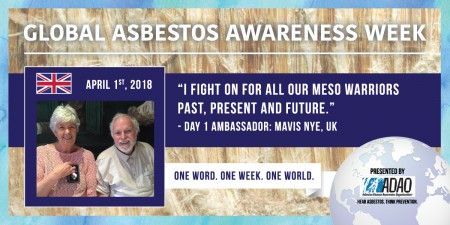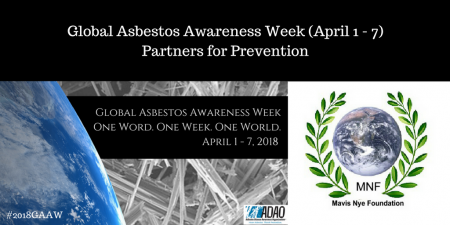Press Release: ADAO Launches 14th Annual “Global Asbestos Awareness Week” April 1-7, 2018
Featured Video: “Asbestos: The Killer You Can’t See”
Featured Story: “I fight on for all our Meso Warriors past, present and future.” — Day One Ambassador: Mavis Nye, UK
Featured on April 1, 2018
Each year, ADAO dedicates April 1-7 to increasing awareness of asbestos and preventing exposure by bringing together experts and victims from around the world to share, learn, and take action. To view all 7 days of Global Asbestos Awareness Week (GAAW) contributors and content on our landing page, please click here. Also, be sure to follow the conversation on Twitter with our GAAW hashtag: #2018GAAW.
 Asbestos is a known carcinogen and there is no safe level of exposure. Throughout the 19th century, asbestos was widely used in construction, shipbuilding, the automotive industry, and various types of manufacturing. Without a ban, asbestos remains legal and lethal in the USA and nearly 70% of countries around the world today.
Asbestos is a known carcinogen and there is no safe level of exposure. Throughout the 19th century, asbestos was widely used in construction, shipbuilding, the automotive industry, and various types of manufacturing. Without a ban, asbestos remains legal and lethal in the USA and nearly 70% of countries around the world today.
Today, we will be highlighting the critical resources from the World Health Organization (WHO) about asbestos exposure and the elimination of asbestos-caused diseases. To have such a globally respected institution disseminating information about the dangers of asbestos is immeasurably important. We are also featuring the powerful personal story from Mavis Nye, our 2018 GAAW Day One Ambassador: “I fight on for all our Meso Warriors past, present and future.
Exposure to asbestos can cause mesothelioma, lung, gastrointestinal, colorectal, laryngeal, and ovarian cancers; as well as non-malignant lung and pleural disorders.
What does than mean? In the USA it is estimated that 2,500 – 3,000 Americans die annually from mesothelioma. Using the WHO risk ratio, that means an estimated 15,000 – 18,000 Americans die annually from asbestos-caused lung cancer.
The WHO estimates that more than 107,000 deaths around the world each year are attributed to occupational asbestos exposure, yet most people are unaware of its existence and dangers. This is especially problematic because asbestos-caused diseases are 100% preventable — you just have to prevent asbestos exposure. Awareness and education campaigns by the WHO, GBAN, ADAO, and other public health organizations aim to help people learn lifesaving prevention techniques.
A 2006 WHO paper offered four essential recommendations to eliminating Asbestos-Related Diseases:
- Recognizing that the most efficient way to eliminate asbestos-related diseases is to stop the use of all types of asbestos
- Providing information and incentive for replacing asbestos with safer substitutes
- Taking measures to prevent exposure to asbestos in place and during asbestos removal (abatement)
- Improving early diagnosis, treatment, and social and medical rehabilitation for asbestos-related diseases
In 2014, the WHO published another useful resource, the Chrysotile Asbestos report, which explains the health risks attached to exposure to chrysotile asbestos, dispelling the propaganda-fueled myth that deadly chrysotile is a “safe” form of asbestos.
As we continue to fight for a global asbestos ban, unbiased, scientific institutions like the WHO are crucial in disseminating information and resources to help reduce the risk of asbestos-caused diseases. Be sure to keep up with the latest news and research coming from the WHO by connecting with GBAN and ADAO on social media.
Together, we make change happen.
Linda Reinstein
Today, ADAO recognizes the Mavis Nye Foundation for partnering for prevention.


